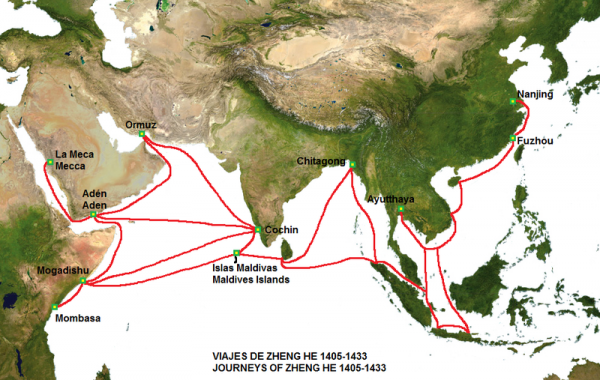For Beijing, RCEP also has the benefit of countering the US-led Trans Pacific Partnership.
Yet the benefit for China of achieving either of these objectives would pale in comparison to the potential benefit of President Xi Jinping’s realising his dream of reviving the ‘maritime silk route’, which he unveiled during his October 2013 visit to Malaysia and Indonesia. The route would build on the East Asia region’s proven strengths in sharing production. It could also enable a greater role for overseas Chinese communities in forging relationships to reduce regional tensions.
The movement of goods along the maritime silk route has a history of over two millennia, which reached its peak in the 15th century when legendary explorer Zheng He led an armada from China through Southeast and South Asia to the Persian Gulf. Today some of these same corridors support East Asia’s unique production sharing network which brings components produced throughout the region to China for assemblage and shipment to Europe and North America.
The production network allows all countries, regardless of their size and technological sophistication, to benefit from deep specialisation and economies of scale by producing parts and components, and adding value to production along the production chain. With labour costs in China now rising, many ASEAN economies stand to gain from any future outsourcing of production. This, combined with the trade deficits that China runs with most of its Asian neighbours (in contrast to its persistent surpluses with the West), makes it easier for ASEAN countries to see China as an opportunity rather than a threat.
Shifts in the pattern of capital flows will also affect economic relationships as China moves from being largely an absorber of funds to a major provider of direct investment and portfolio flows. China’s structural trade deficits within East Asia also make it easier to promote the RMB as a regional currency to settle trade balances. This in turn would help internationalise the RMB.
The new silk route provides an opportunity for Beijing to build on the role played by the Chinese diaspora in Southeast Asia. Approximately 32 million of the 50 million Chinese who live abroad reside in Southeast Asia. They account for a considerable share of the wealth in a number of ASEAN countries, and play key roles in the production network, aspects of which are coordinated out of Hong Kong, Singapore and Taiwan.
During China’s opening up when its legal framework for protecting foreign investment was undeveloped, overseas Chinese accounted for as much as two thirds of FDI flows into China. They were able to leverage their identity, understanding of cultural norms and personal networks to mitigate some of the inherent risks faced by non-Chinese foreigners. This same group could play a reverse role in facilitating China’s outward investment in Southeast Asia by helping to develop major ports, outsourcing industrial production, deepening banking relationships and widening channels for distribution.
Overseas Chinese continue to exhibit an enduring cultural connection to China despite assimilating and naturalising to host countries abroad. But they have gone through complex historical and political shifts that have complicated relations between China and their host countries, as well as between other social communities within these countries. The influence of overseas Chinese on foreign policy is subject to diverse motivations, but so far there is little to suggest that the diaspora has played a particularly active role.
If this is to change, there are a number of barriers which will have to be carefully addressed. Wariness among many ASEAN countries toward China will likely limit the effectiveness of approaches taken with overt foreign policy objectives in mind. Most overseas Chinese do not share a bond with China beyond purely economic interests. Other local populations throughout Southeast Asia remain concerned about how greater engagement with China will benefit them directly. Such feelings are more extreme in countries like Vietnam and the Philippines, but they are also present in varying degrees in Malaysia, Indonesia and Thailand.
The challenge is reaching out to a broader range of communities beyond the Chinese diaspora. This inevitably means that any major initiatives would need to be done under the umbrella of government-to-government relations, which would provide a reassuring framework to encourage informal contacts with overseas Chinese at the firm or individual level.
More inclusive interactions going beyond diaspora communities could help to moderate regional tensions over territorial disputes and historical sensitivities. The credibility of these approaches would increase significantly if China and the other countries concerned could agree on joint development of disputed maritime resources and set aside their competing sovereignty claims. This would help to ensure that any revitalised maritime silk route results in more positive foreign policy outcomes. And it would help China in its other economic diplomacy objectives too.
Yukon Huang is Senior Associate at the Asia Program, Carnegie Endowment for International Peace, and a former country director at the World Bank in China.
A version of this article was first published here by The Diplomat.


Dear Yukon,
A smart way through is to extend the RCEP to be an initiative for broad cooperation, including improving connections consistent with the silk road initiative.
If interested, I can send you a recent presentation on that.
Best wishes
Andrew
Andrew – would appreciate your sending me your presentation.
Yukon